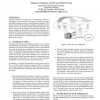322 search results - page 27 / 65 » An Example of an Automatic Differentiation-Based Modelling S... |
CVPR
2001
IEEE
16 years 1 days ago
2001
IEEE
We consider learning models for object recognition from examples. Our method is motivated by systems that use the Hausdorff distance as a shape comparison measure. Typically an ob...
OAS
2003
14 years 11 months ago
2003
This paper illustrates an approach to combining the benefits of a multi-agent system architecture with the use of industry-standard modelling techniques using the Unified Modeli...
148
click to vote
ACCV
2010
Springer
14 years 11 months ago
2010
Springer
Humans have abstract models for object classes which helps recognize previously unseen instances, despite large intra-class variations. Also objects are grouped into classes based...
DATE
2006
IEEE
15 years 4 months ago
2006
IEEE
We present a modular and scalable approach for automatically extracting actual performance information from a set of FPGA-based architecture topologies. This information is used d...
IPPS
1998
IEEE
15 years 2 months ago
1998
IEEE
Using a directed acyclic graph (dag) model of algorithms, we solve a problem related to precedenceconstrained multiprocessor schedules for array computations: Given a sequence of ...

